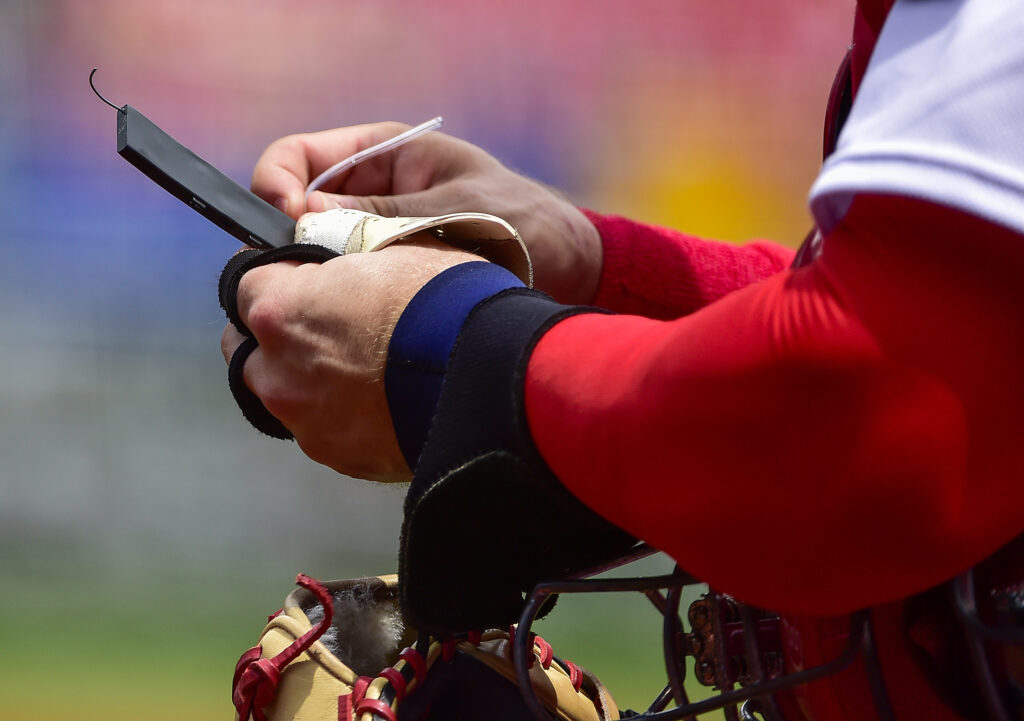In baseball, every second counts. Coaches and players are always looking for ways to communicate faster, protect their secrets and get an edge. One of the biggest changes in recent years has been the adoption of electronic pitch calling systems. Instead of relying on hand signals that can be stolen by opponents, teams are using secure digital tools to send calls in real time.
This is not only speeding up the game but changing how coaches and athletes prepare, strategize and compete.
MLB and electronic pitch calling
MLB teams are using electronic pitch calling systems, notably a technology called PitchCom, which has been widely adopted since the 2022 season to help prevent sign-stealing and improve the speed of the game.
- By 2023, pitchers were also allowed to initiate pitch calls directly using wearable PitchCom transmitters. Most MLB teams now use some version of electronic pitch calling as the standard method, with both catchers and pitchers participating.
- These systems are approved for all official MLB games, and usage is highly encouraged, especially when there are runners on second base, to prevent sign-stealing.
- MLB permits each team to have a limited number of PitchCom transmitters and receivers on the field (up to 2 transmitters and 5 receivers at a time).
- Devices only provide one-way communication, and their use is strictly controlled to prevent any unfair advantage, including prohibition on WiFi or external communications.
Why electronic pitch calling is taking off
Traditionally pitch calls went from the dugout to the catcher through hand signals, often taking valuable seconds. Opponents studied those patterns and once signs were cracked the advantage was gone.
Electronic pitch calling eliminates that risk. Coaches send calls through encrypted devices to a wrist receiver worn by the pitcher and catcher. The message is clear, immediate and almost impossible to intercept.
For many programs this means:
- Faster tempo – less downtime between pitches.
- More accuracy – no confusion from missed or misread hand signs.
- More security – less risk of stolen signs.
It’s not just about convenience it’s about leveling up game day tactics.
How teams are using electronic pitch calling to compete smarter
1. Protecting strategy
Sign stealing has been part of baseball for a long time but technology raises the stakes. Electronic pitch calling gives coaches peace of mind their instructions are private. Teams no longer waste energy wondering if an opponent has cracked their code – they can focus on execution instead.
2. In game adjustments
Because messages come in instantly, managers can switch strategies on the fly. If a hitter shows a tendency mid game the call can be changed in seconds. This flexibility allows teams to adjust inning by inning without slowing down.
3. Supporting player development
Younger athletes benefit too. With clear calls delivered digitally they don’t have to memorize long sets of signs. This frees them up to focus on mechanics, timing and awareness on the field. Over the course of a season the learning curve shortens dramatically.
4. Coach athlete communication
In high pressure situations clarity is key. Electronic systems eliminate misinterpretation especially in loud stadiums or under bright lights where hand signals can be missed. Both pitcher and catcher get the same instruction at the same time so everyone is on the same page.
5. Real world adoption
From high school to MLB, teams are using electronic pitch calling. The NCAA approved its use in baseball and softball so many programs are experimenting. For MLB, it’s been adopted since 2022. Coaches are reporting faster innings, fewer disputes over missed signs and a smoother overall rhythm to the game.
Common concerns – and how teams address them
Like any new approach electronic pitch calling comes with questions:
- Technology failure: What if the device fails mid game? Most systems have quick reset functions and backup options. Coaches also keep traditional signs ready as a contingency.
- Cost: Schools on a tight budget wonder if the investment is worth it. Many find the long term benefits – faster games, better communication and less risk of sign stealing – outweigh the upfront cost.
- Learning curve: Players and staff need to practice before using it in live game situations. Training sessions and scrimmages usually resolve this quickly.
Overall the benefits outweigh the hurdles once teams commit to the transition.
The competitive edge
Baseball and softball are often described as mental games as much as physical ones. Success depends on how well a team anticipates, reacts and protects their intentions. Electronic pitch calling supports all three:
- Anticipation by allowing coaches to deliver pitch sequences with precision.
- Reaction by letting teams switch tactics without tipping off the opponent.
- Protection by safeguarding strategy in a way hand signals never could.
This is more than a tool–it’s a competitive safeguard.
Looking ahead
As electronic pitch calling grows the bigger question is how will it change the culture of the game. Some purists will say it erases an old tradition. Others will say it’s the next step in a game that has always evolved with new bats, gloves and training methods.
What’s clear is teams that are using it are gaining confidence in strategy and execution. They’re spending less time signaling and more time focusing on the next out. That alone can turn a close game into a win.
Main Image: Jeff Curry-Imagn Images



